If you wanted to travel around Champaign-Urbana in 1899, chances are you rode in a horse-drawn carriage, a streetcar, or walked. Most homes were heated by coal-burning furnaces, though a fortunate few enjoyed the warmth of coal-fired steam boilers. Water was brought to homes through wooden mains that were in the process of being replaced by cast-iron pipe. The individual services connecting water to homes and businesses were made of lead. Indoor toilets were slowly being adopted and greater care taken to prevent contamination of water supplies by raw sewage. All in all it was a very different world than the one we enjoy today.
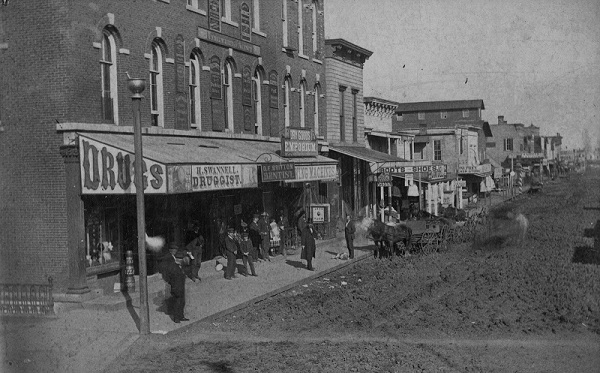
Downtown Champaign circa 1899
Yet even back then–over a century ago–workers recognized the necessity of protecting their jobs and their rights. For those in the pipe trades, this meant becoming members of the United Association of Plumbers, Gas Fitters and Steam Fitters and Steam Fitters Helpers, who organized Local 149 here in Champaign-Urbana in 1899. These men came together in order, as their charter noted, “to protect members from unjust and injurious competition” and to “secure through unity of action among all workers in the trade” protection from the greed of corporations and employers.
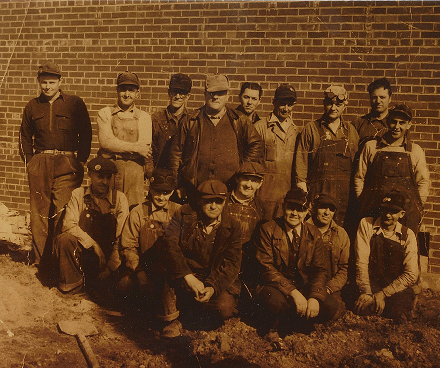
Champaign County Pipefitters
These Champaign County workers were part of a proud tradition in the pipe trades that extended back to the 1820s when such skills helped bring gas street lighting to America’s fledgling cities. In the 1830s, 1840s, and 1850s, the trade evolved into its major components– plumbing, steam fitting, and gas fitting. Workers from these trades played a role in one of the first strikes in the United States–an 1835 action to gain the 10-hour day in Philadelphia. Bouncing from labor organization to labor organization as either repression or internal disagreements or both snuffed out attempts to create alliances across trade lines, some the pipe trades workers finally organized their own union–the United Association–in 1889. Within a few years, the United Association had spread across the United States and, by the turn of the century, merged with the steam and water fitters to form the present organization.
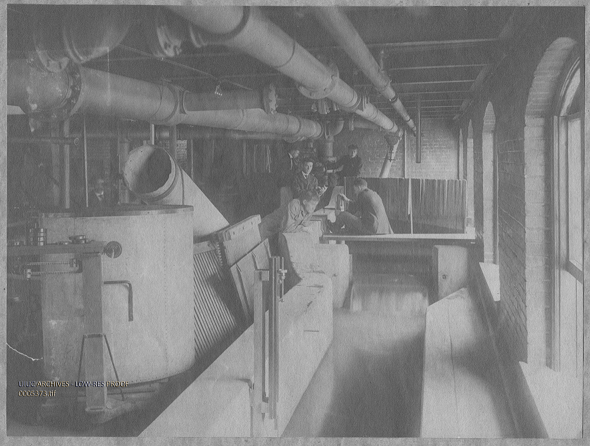
Sanitary Engineering Testing circa 1919
A growing community concerned for the safety and health of its members needed an organization that ensured quality and reliability in the trade. Union plumbers and fitters worked hard to make this happen. The typical work week consisted of nine-hour days, six days a week, for 36 cents an hour. And the work was hard. All piping was cut by hand, except for cast iron which had to be cut with hammer and chisel. For cast-iron water main, the job required a coldcut and a sledge hammer. Steel piping was cut with a three-wheeled cutter held in place with chain tongs and then threaded by hand. Steel piping was lowered manually into ditches. Sanitary lines were installed by means of poured and caulked lead joints. Small waste lines had wiped lead joints that could only be fabricated by skilled craftsmen. There were no safety codes and the construction trades were very dangerous. The health and safety of entire communities depended upon the skill and dedication of these workers.
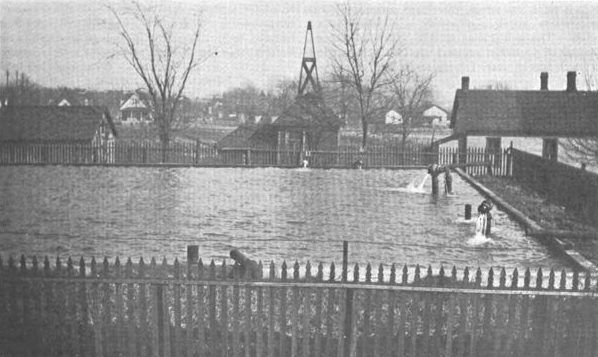
Upper Reservoir of Champaign-Urbana Water Company
Surviving the tough 1890s, UA Local 149, like the other skilled trades unions, enjoyed steady growth in the opening decade of the 20′ Century. After World War I, construction boomed in Champaign-Urbana. Memorial Stadium and the Wesley Foundation were both started in 1920 and finished in 1923. Money to fund the stadium was raised by the relatives of WWI casualties from this area and their loved ones names were engraved into the structure’s columns. Yet, as the 1920s proceeded, a strong anti-union sentiment took root in government and business. Unions were often under attack, but, like others, Local 149 held on. The arrival of the Great Depression in 1929 posed another challenge but Local 149 members demonstrated solidarity by working part-time two to three days per week in order to ensure everyone would have enough work to survive.
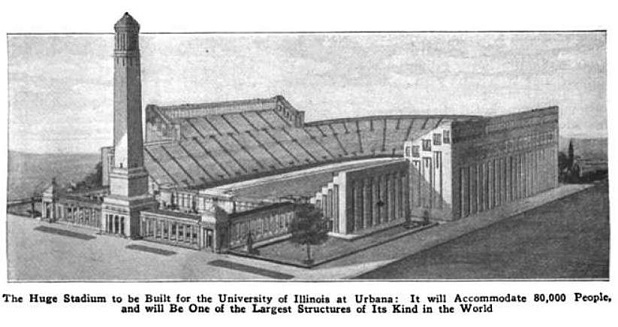
Memorial Stadium Model 1921
As the United States prepared for World War II, the skilled craftsmen of Local 149 played an essential role in building the industrial juggernaut that supported the troops in the field, on the sea, and in the air. Members worked on ammunition plants in Indiana and in the expansion of Chanute Field. Expansion at the University of Illinois also provided work. War’s end brought a rush of other needs, especially housing for returning veterans and their families. Opportunities provided by the G.I. Bill helped drive the University of Illinois’ enrollment up from 7,000 in 1945 to 20,000 in 1946. “Stadium Terrace,” a housing development built by the government between First and Oak Streets and St. Mary’s Road and Gregory Street, provided homes for many of these students. And as the population increased, so did demand for water. A larger and more dependable supply was found in the Mahomet Aquifer.
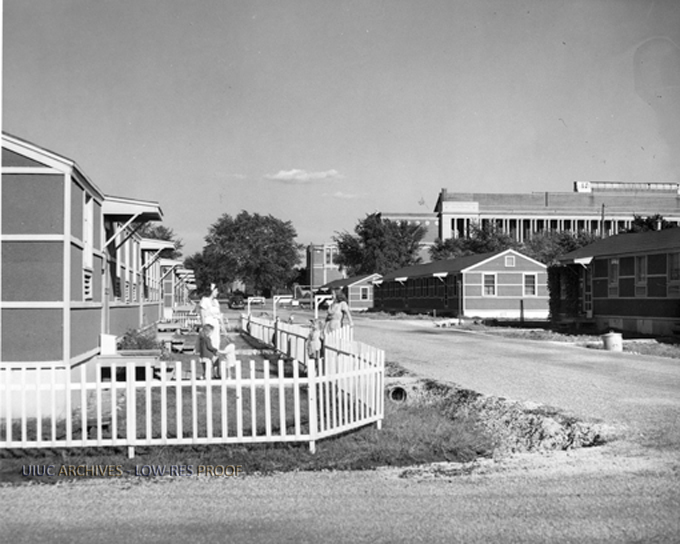
Stadium Terrace
There was work away from campus as well. From the 1940s to the early 1960s, the city of Champaign fed steam heat through tunnels provided by Illinois Power. Each building had to provide its own heating system because Illinois Power found it too expensive to supply steam for heat. The need to provide gas-fired heating systems brought prosperity to the fitting industry.
As the national economy boomed in the postwar years, Local 149’s membership grew and an apprenticeship program was launched. The first apprenticeship classes met at the Champaign High School building trades facility. However, by the fall of 1959 it was clear the program had outgrown those facilities. The apprentice school was moved to the Borden Milk plant on Oregon Street in Urbana, where it remained until the present union hall and apprentice training center was opened in 1967.
Throughout the 1960s, smaller locals began merging with larger ones to improve services to members. In 1960, Local 563 at Mattoon voted to merge with Local 149 and on January 30, 196 1, the two locals became one. By the action, Local 149’s jurisdiction extended from Ford County to Effingham County and from Illinois 105 in Piatt County on the west to Vermilion County on the east.
The baby boomers reached college age in the 1960s and the University of Illinois expanded again. Local 149 members played a role in these projects which included the Assembly Hall, the Music Building, and many dormitories. Chanute Air Force Base was also expanding, as were the Humko and Kraft factories. Housing and business construction boomed. Sometimes as many as 1,500 travelers were working out of Local 149. Steady employment for the pipe trades at the University of Illinois and the general economic climate made the future appear promising. During the late 1960s and early 1970s, the local’s apprenticeship program grew to include 50-60 apprentices. In the early 1970s night school was replaced by day school and many of the local’s best journeymen taught their skills at the school.
Economic climates don’t remain unchanged and inflation and recession marked the 1970s. Things got worse with the election in 1980 of Ronald Reagan who fired striking air traffic controllers, signaling the start of a wave of anti-labor actions by private business. The recession of the early 1980s hit Local 149 hard and a fund was established to ensure that members would not lose their health and welfare benefits. Not until the election of Bill Clinton in 1992 removed the curse of “trickle-down” economics did things begin to change. The growing economy of the 1990s was good for Local 149, but, like so many other industries, the Union struggled through the early 2000’s. Fortunately, however, as consumers remember the importance of quality work and a job well done, the last few years have brought new jobs and projects to Local 149.
As it faced the challenges of 100 years, Local 149 has called many different locations home. Meetings have been held in various places, including the City Building, the Carpenters Hall, the Laborers Hall on Walnut Street, and on the second floor of Bailey & Hines, which was also the location of the first union office. In 1967, Local 149 completed a $250,000 building south of Champaign on U.S. 45. Today, this building houses the local’s business offices, special training equipment, the apprentice school, and a 250-seat meeting hall. Despite some upgrades over the years to the training facilities and the local’s communications network, Local 149 is currently looking to relocate to a new facility in order to meet the needs of its members and the community.
Local 149’s first century has not been without pain and suffering, but this strong and enduring organization has survived even the worst of times. Secure wages, safe working conditions, health and welfare plans, a pension plan, and an excellent educational facility for carrying on the trade have been among the benefits guaranteed by the commitment of the local’s members over the decades.
